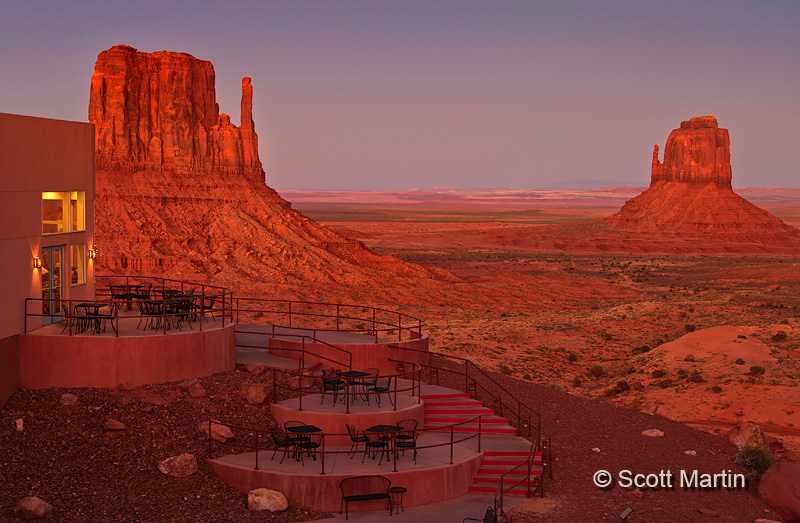
by Scott Martin Photography | Feb 24, 2012 | Blog, Landscapes, Naturescapes, Travel
Monument Valley is a vast area within the Colorado Plateau which is characterized by huge sandstone buttes and mittens, the largest of which are over one thousand feet high. Monument Valley is part of the Navajo lands and all of the images in this post were taken within the 92,000 acre Monument Valley Navajo Tribal Park. Monument Valley is entered off Hwy 163 just south of the Utah, Arizona border and a few miles west of the Four Corners. For the trivia buffs, the Four Corners is the only place in America where the borders of four states meet….Arizona, Utah, Colorado and New Mexico.
While in Monument Valley, Deb & I stayed in the The View Hotel which was a terrific spot and every room has a view like no other hotel you have ever stayed at. When in the area, this is the only place to stay if you want to capture incredible sunrises and sunsets without leaving your room. Here is a twilight image of the West and East Mittens (and hotel dining room entrance) taken from our balcony.

.
Monument Valley is a wonderful place to photograph; the awe-inspiring beauty of the landscape, the sheer size of the buttes & mittens and the dynamic light creates ever-changing colour hues within both rock and sky so each image is different from the other even though the object remains the same. The following images are an attempt to show case the three sandstone formations that comprise the famous Monument Valley Panorama; the West Mitten, East Mitten and Merrick Butte.
The first five images are sunsets.
The Mitten Buttes (West & East)
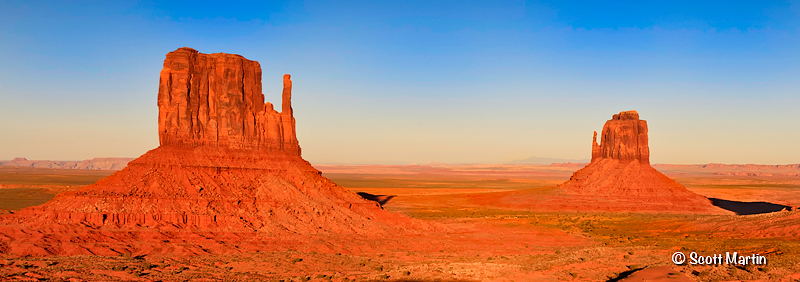
The West Mitten
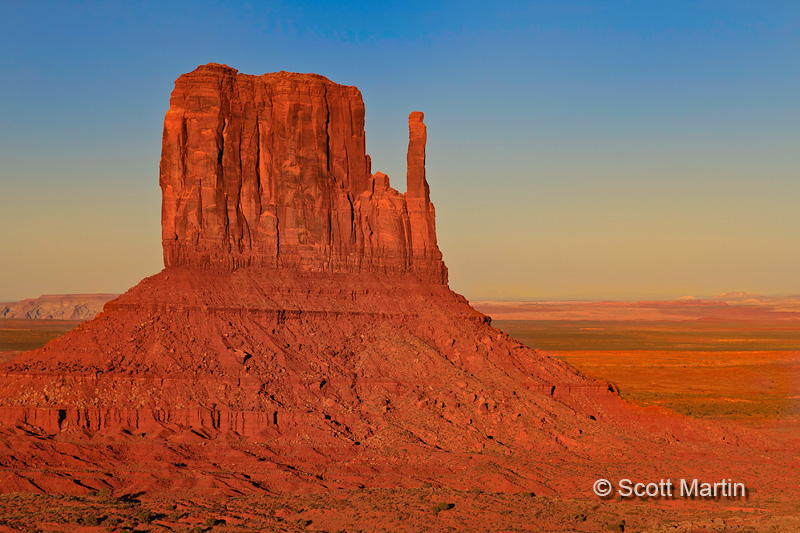
The East Mitten
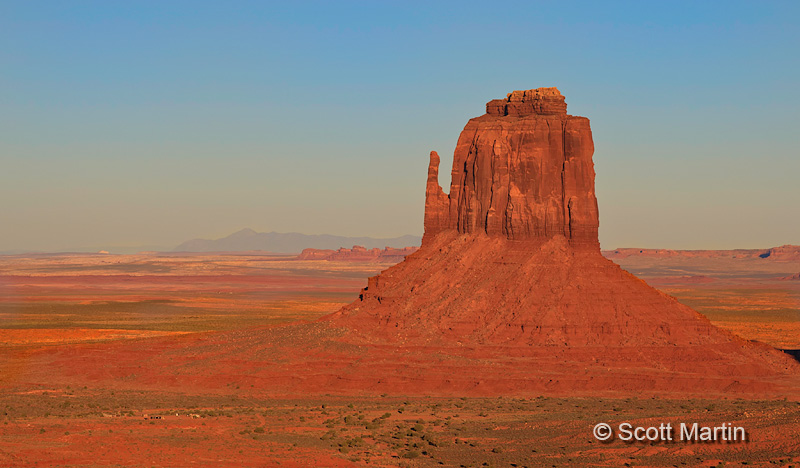
The East Mitten and Merrick Butte
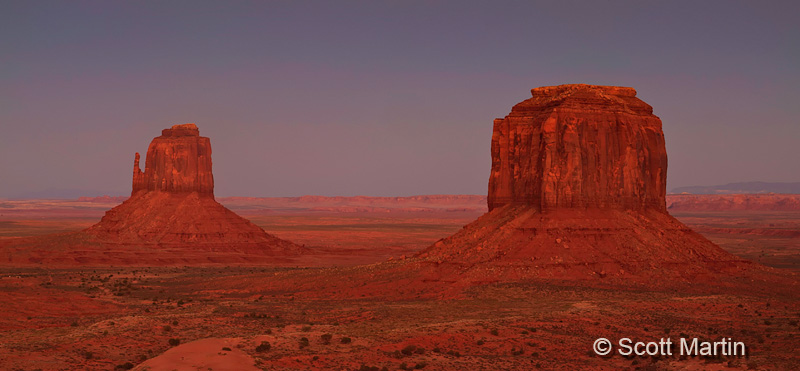
The same shot, different time, different sky….amazing!
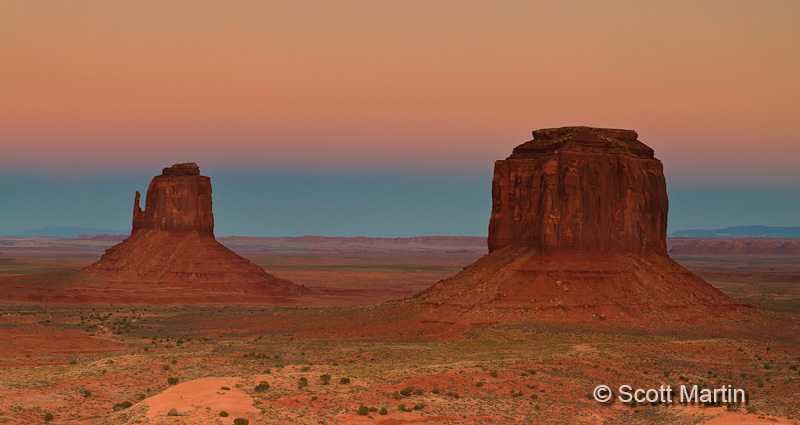
The following images are sunrise shots and as is often the case the photographs taken before sunrise are the ones that catch your eye.
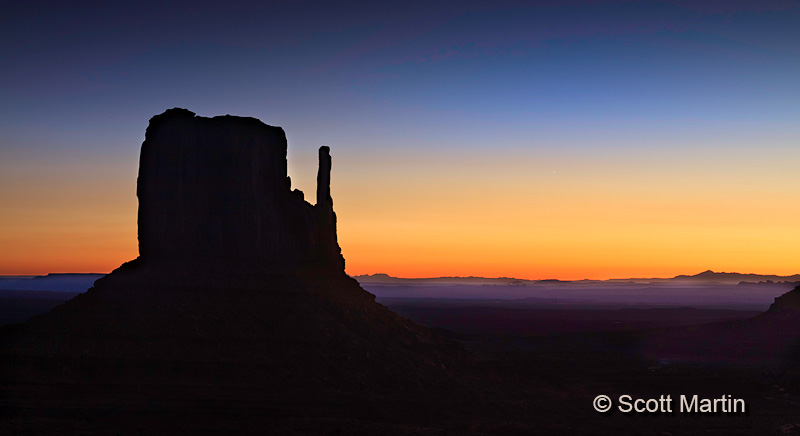
.
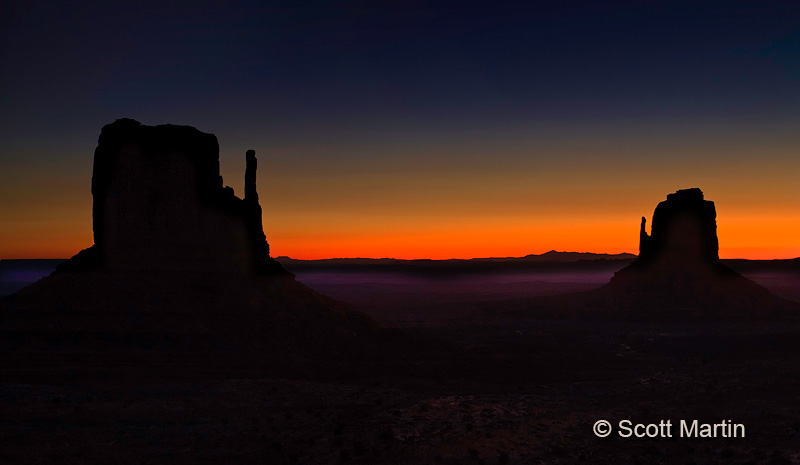
.
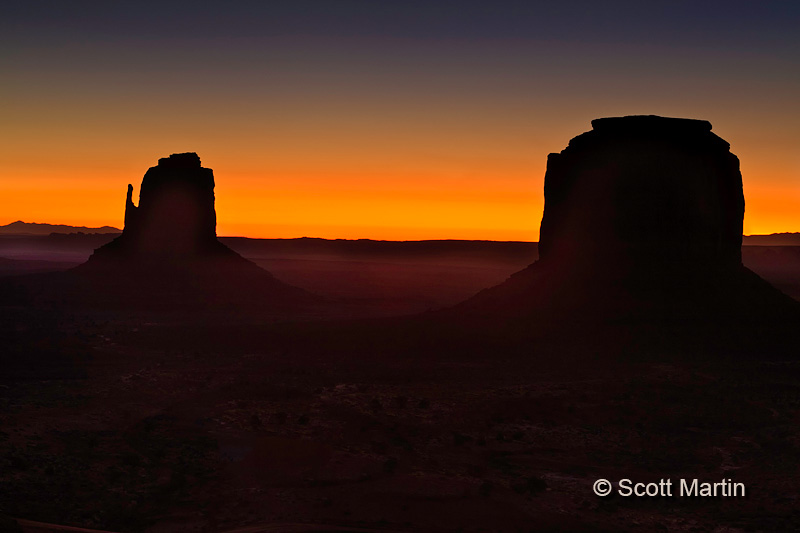
.
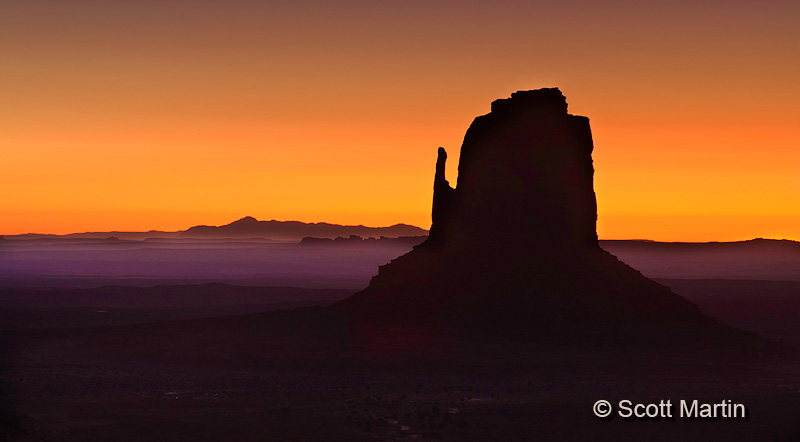
.
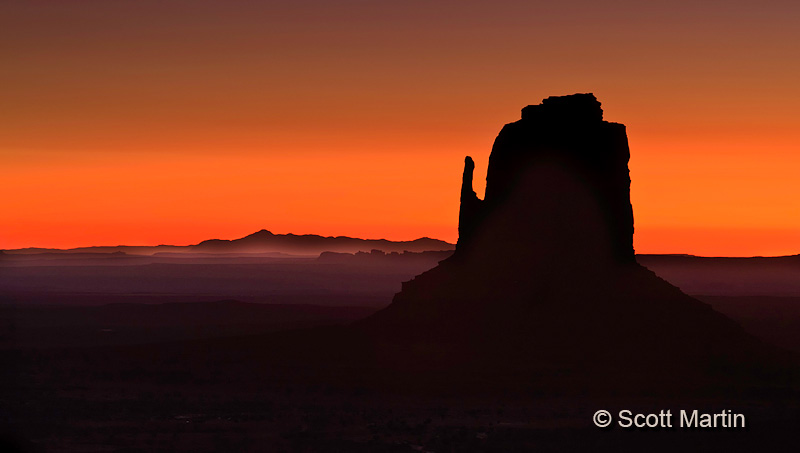
.
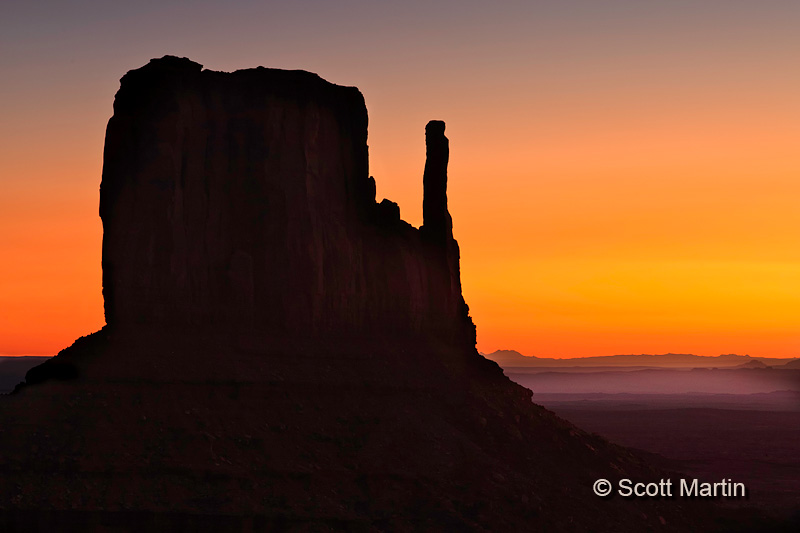
.
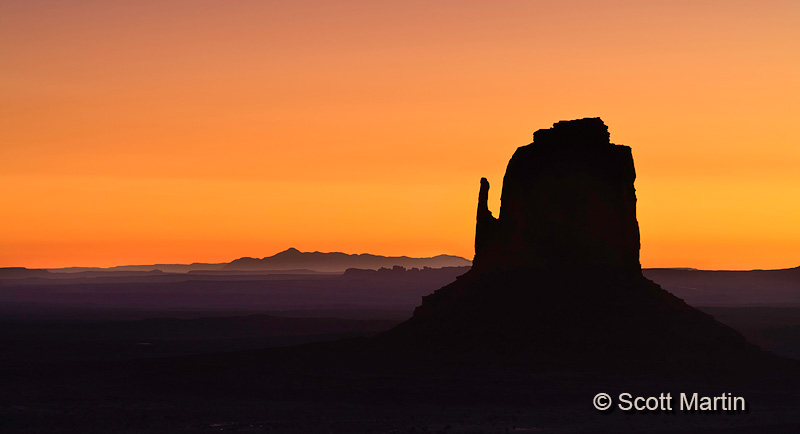
.
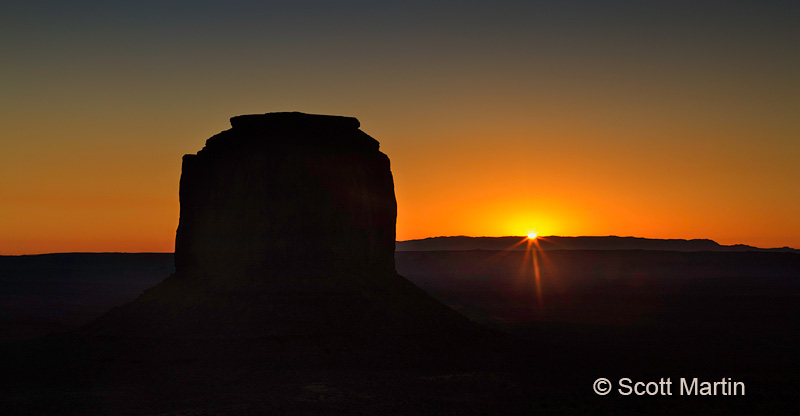
.
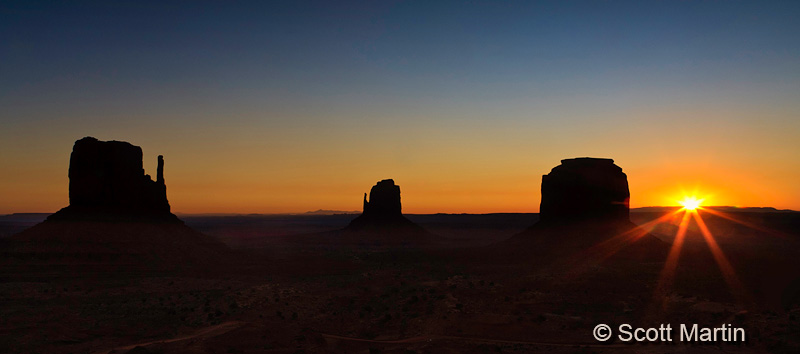
If memory serves me correctly these images were taken using three different lenses; 16-35/2.8; 24-105/4 and 70-200/2.8 Most of this series was also taken using 4×6 Lee ND Grad filters.
After watching the sunrise we headed out into the valley where there is a forty mile dirt road that winds its way around countless buttes, each one a great photographic opportunity, the result of which I’ll post another time. From Monument Valley we headed North along Highway 163 to Moab Utah and two more incredible National Parks; Canyonlands and Arches.
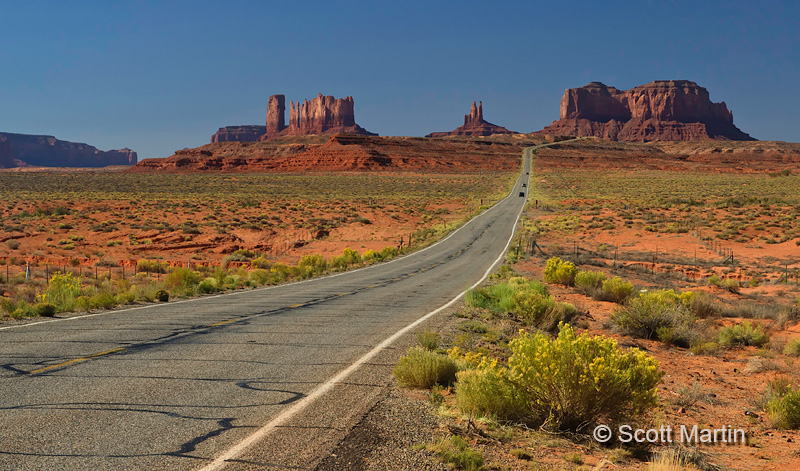
by Scott Martin Photography | Feb 17, 2012 | Blog, Landscapes, Naturescapes, Travel
Heading southwest towards Monument Valley on Route 163 near the Utah Arizona border you are greeted by one of the most iconic open road views in the country. Our first glimpse of this amazing vista was in the rear view mirror as we were heading North towards Moab at the time! No doubt you have seen pictures similar to the ones posted today, however I trust you also enjoy these. Please feel free to comment on them and let me know which perspectives you enjoy the best.
The five images to follow were all taken hand-held at focal lengths ranging from 16-105 mm, with the perception of the depth of the image being progressively compressed at the focal length increases. One of the ‘rules’ of wide-angle landscape photography is to have something of interest in both the foreground and background , however this creates a problem for shots like these where the topography is pretty nondescript save for the incredible buttes and mittens that are at least five miles away. To try to follow the rules of composition, I found the largest bush along the road side and positioned it in the foreground of the image, making sure to have the camera high enough that separation was maintained between the bush and the background rock formation.

This next shot was taken from the same general spot as the first image (you can see the bush used as foreground object in the last shot on the right side of this image as well). The only differences being focal length (24mm) and lower camera height to change the perspective making the road more prominant. For this shot I was lying down so the camera was only about six inches above the road. This image is a single frame, cropped to create the panoramic look.

The last three images attempt to find a pleasing balance of perspective and composition resulting in a great photograph, or moving the image from a snapshot to a photograph.
The next image is just a snapshot, taken with the camera at standing height from relatively close to the rock formation. Being too close to the background stops the road from disappearing into a long thin ribbon which takes a way the feeling of great distances and also reduces the ability to sense just how big the rock formations actually are. Both of these problems are compounded by the longer focal length chosen to take the image (105 mm).
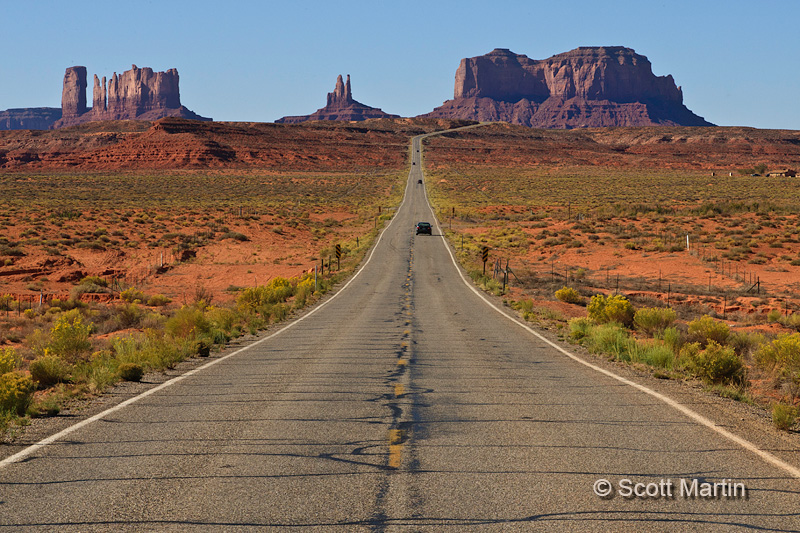
The last two shots come the closest to working well at conveying the feeling of what it was like to actually be there. The next image was taken from the farthest point away from the buttes which were about four or five kilometres away. It was taken standing to reduce the relative size of the road in the foreground and including a bend in the road to change the way your eyes are led towards the buttes and mittens in the background.
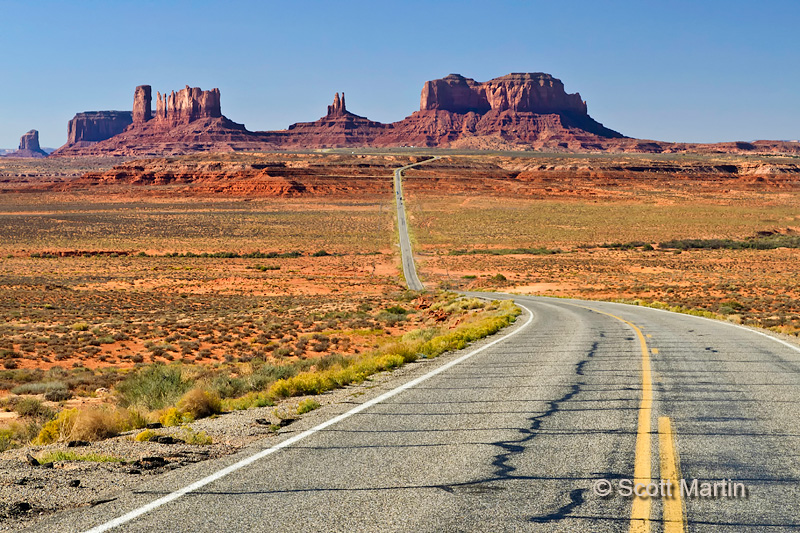
The last image is my favourite of this group. It was taken from a sitting position in the middle of the road to enlarge the presence of the road slightly as well as allowing the small berms on the roadside to provide some foreground interest. Plus the straight road into Monument Valley takes you immediately to the object of the image. The shot was taken at 65mm at f/16 at 1/100 sec.
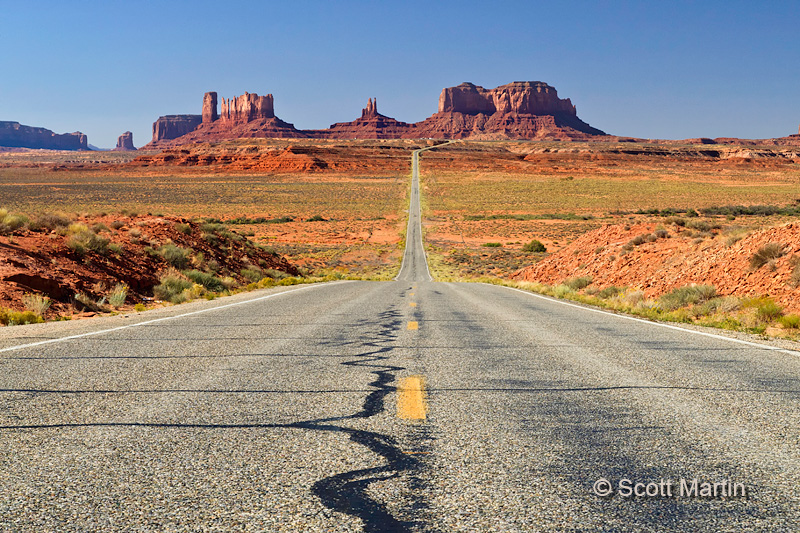
The enjoyment of an image is a purely subjective thing, we either like it, don’t like it or are ambivalent towards it. The trick with good photography is to deliver images that someone other than yourself actually likes! To do that we need to learn to always be thinking about the pictures we are taking, and then experimenting with different variations of the same scene like I’ve tried to demonstrate with these images of Monument Valley. The more thought one puts into the exercise before pressing the shutter really helps deliver consistently better images. It is so much easier to improve your skills in the digital age as CF cards are inexpensive and we can take lots of images in order to arrive at a couple of good ones. For this series Deb & I probably spent an hour or so stopping at four or five different spots along the highway and taking about seventy-five images.
If you haven’t already been there, plan a trip to Monument Valley. You will be glad you did!
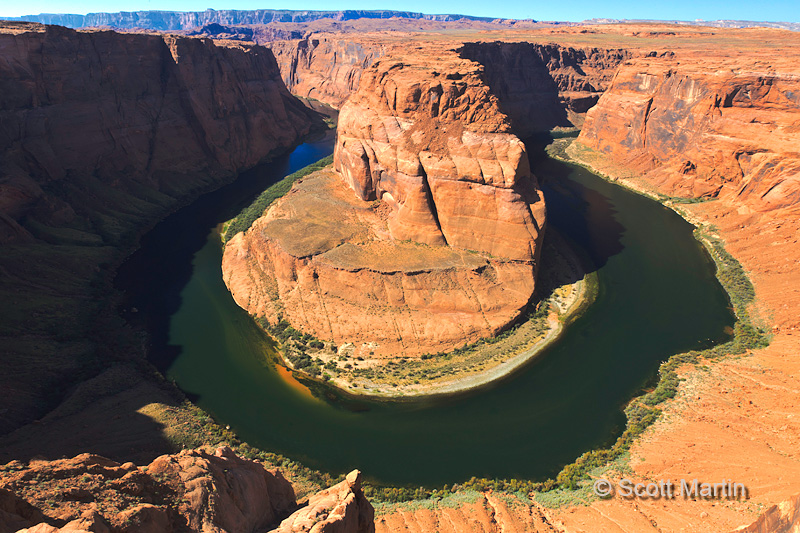
by Scott Martin Photography | Feb 11, 2012 | Blog, Landscapes, Naturescapes, Travel
The Horseshoe bend in the Colorado River is located just outside of Page Arizona just west of Highway 89. It is one of the most impressive vistas along the river and has become an iconic image of the Grand Canyon area. The Bend is reached by a rather short trail of three quarters of a mile, however the soft sand over most of the trail makes for a rather arduous trek and there is absolutely no shelter from the sun, so remember to take lots of water with you.

Taking a good picture of the bend is not done without a little fear and trepidation as the rim is over 1000 feet above the river and in order to keep the entire river in the frame the camera needs to be right on the brink. I set my tripod up as low as possible and crawled the last few feet to the brink on all fours. Once you peak your head over the edge its an awe-inspiring sight; Gods great handiwork right before for eyes! The image above was taken at a focal length of 16mm and is a single image. I have a number of panoramic images of the area which I may post later.
A couple of miles upstream from the Horseshoe bend is the Glen Canyon Dam, which is bigger than its more famous down stream cousin, the Hoover Dam, located just outside Las Vegas, Nevada. The Glen Canyon Dam is 710′ high and 1560′ wide and over 300′ thick at the base. The reservoir it created is Lake Powell, the second largest artificial lake in the States.
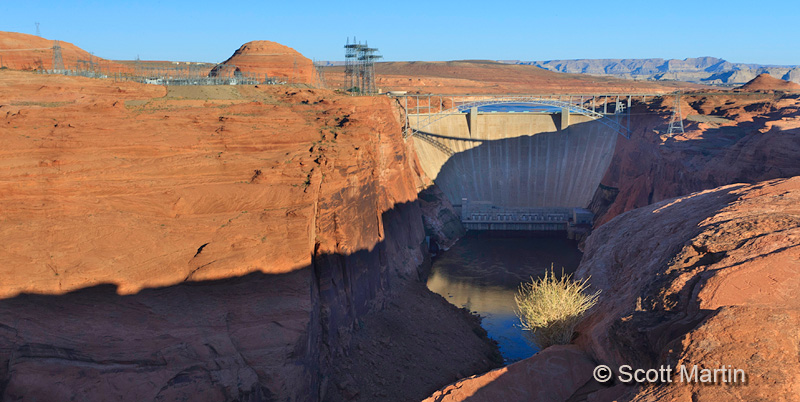
The Glen Canyon Dam was constructed between 1956-1966 while the Hoover Dam was built from 1931-1936.
We were visiting the dam mid-morning after hiking to the Horseshoe bend for sunrise. This created strong shadows across the face of the dam which results in poor images, however here is an attempt to make an artistic shot of a hydroelectric dam.
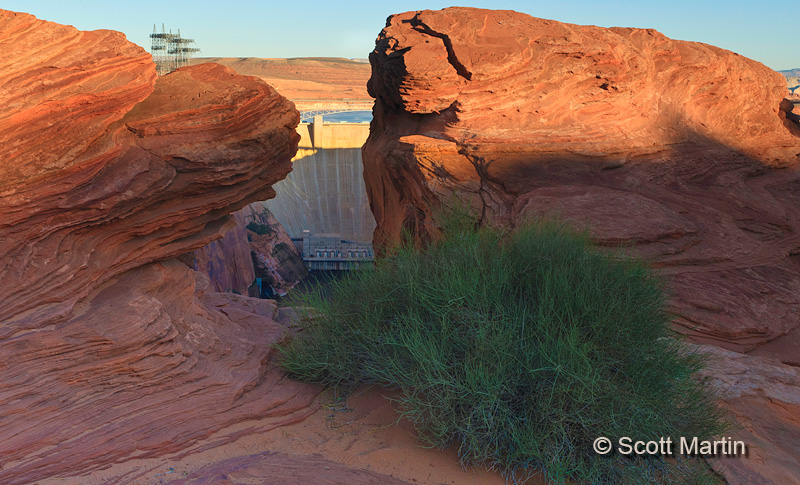
Page AZ is also known for the Antelope Slot Canyons, which are a must see when in the area.
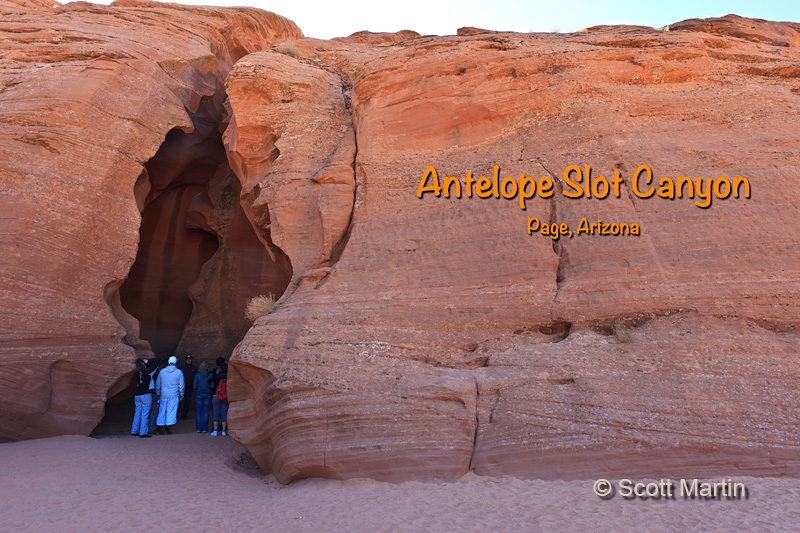
by Scott Martin Photography | Jan 14, 2012 | Blog, Landscapes, Naturescapes, Travel
The Antelope Slot Canyons, located on Navajo lands just outside Page Arizona are arguably the most famous and picturesque slot canyons in the world. The canyons are accessible only with a Navajo guide and a specialized 4×4 truck transports you the last couple of miles from the nearest road to the canyon entrance. We used the services of Caroline Ekis who owns and operates Antelope Canyon Tours. They have dedicated photography tours which limits the number of participants to eight at a time which makes it a bit easier to set up gear, however many other tour groups are also in the canyon at the same time so the biggest challenge is getting a shot without someone walking in front of the camera during the 20-30 second time exposures required in the canyon.

.
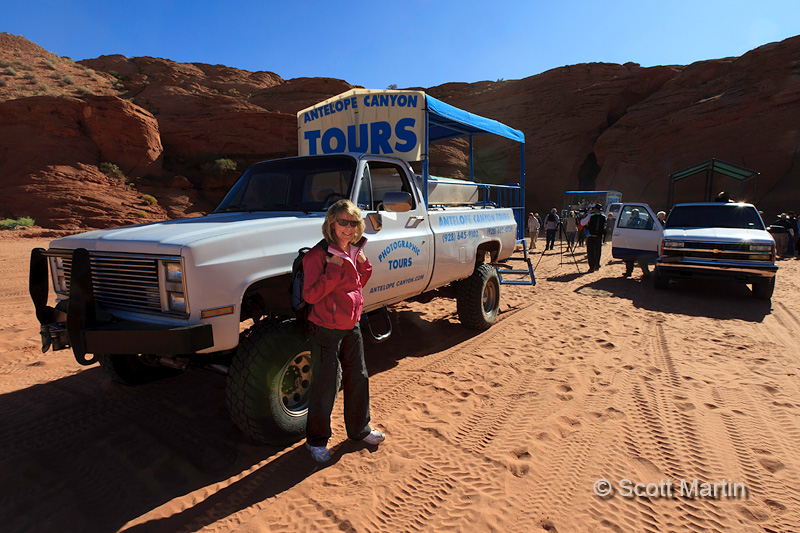
There are two Antelope canyons, the upper canyon which the one we visited and the lower canyon which is close by however requires one to climb down steep stairways to enter and leave the canyon. The slot canyons are formed when flash floods caused by rain storms during monsoon season rush through the sandstone mesas and literally carve the slots through the sandstone. Once the slot is formed, subsequent flooding travels through the same path making the slots deepen over time. Presently the Antelope Slot Canyons range up to 120 feet deep. The Upper Canyon is a little over 1/4 mile long and ranges in width at the bottom from less than three feet to fifteen or twenty feet in some places. If you are interested in more information on the canyons, here is a link to the Wikipedia Antelope Canyon site.
Photographically its a challenge in the canyon for a number of reasons, low available light necessities long exposures and good low light techniques (especially at the low ISO’s and small apertures required to minimize noise and maximize depth of field); the tall yet narrow slot requires a wide-angle lens (I used a 16-35mm lens 95% of the time); the EV variation between the top and bottom of the canyon makes exposure bracketing and the use of ND grad filters mandatory; avoiding people and protecting your tripod from getting bumped during exposure was a constant challenge.
Below are some images taken during the two hours we were allowed to remain in the canyon. The first is the entrance way where there is still lots of light.
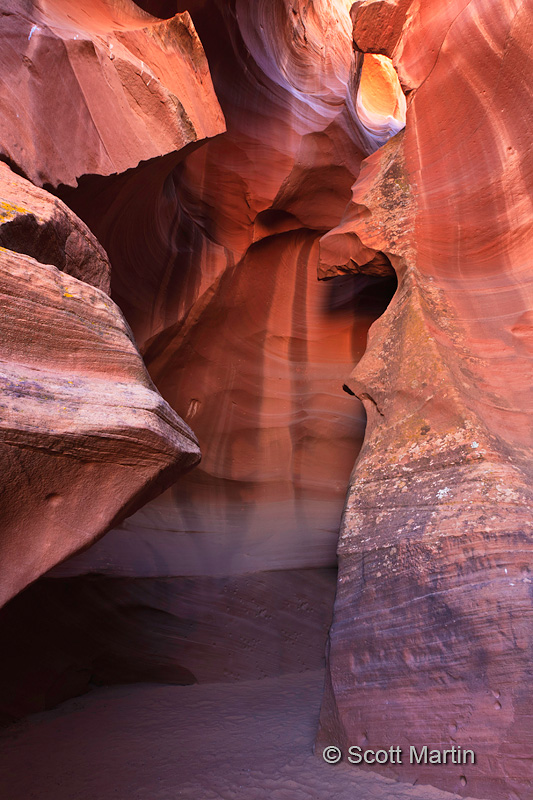
.
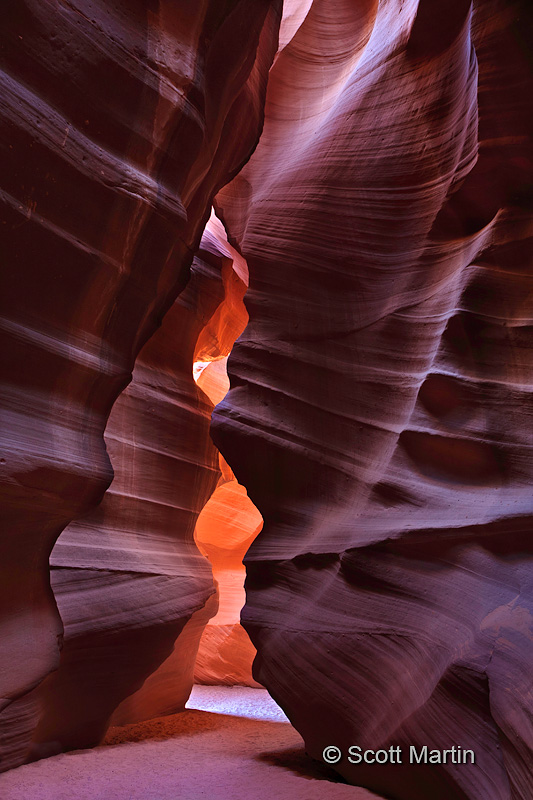
.
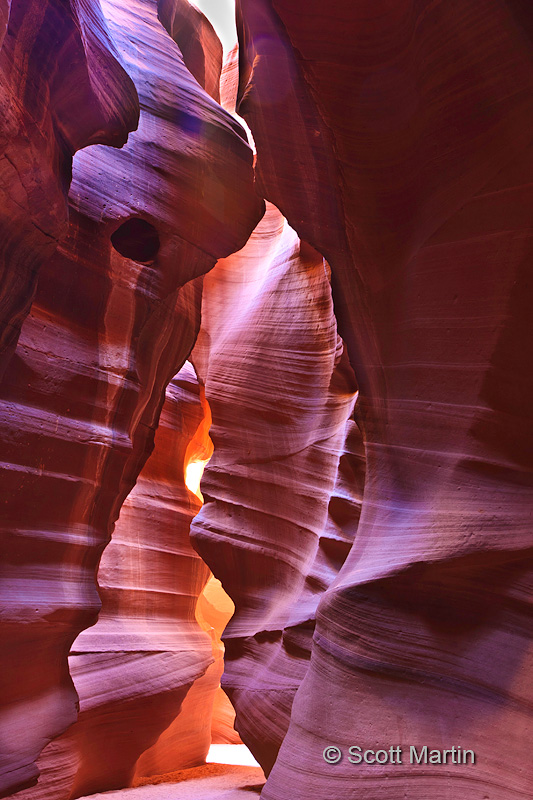
.
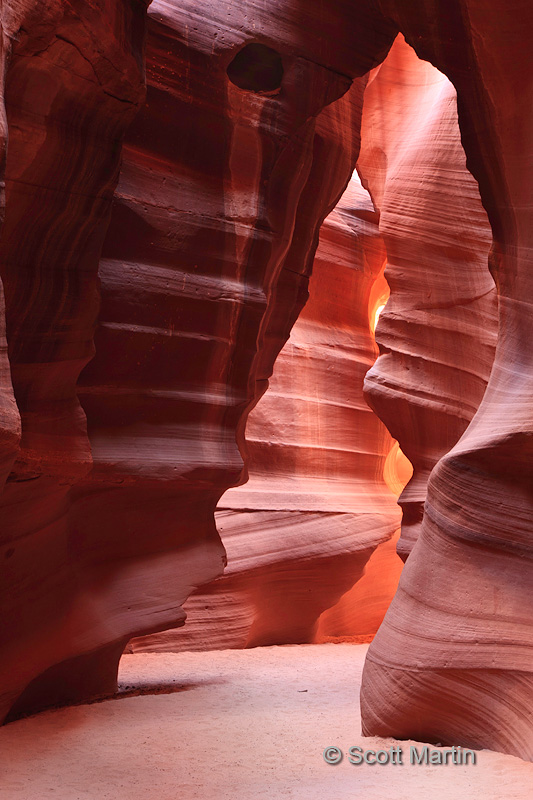
.
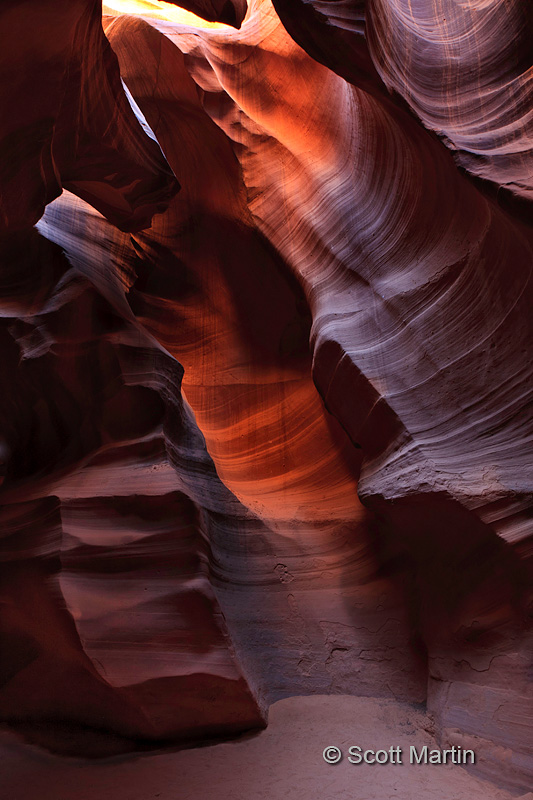
.
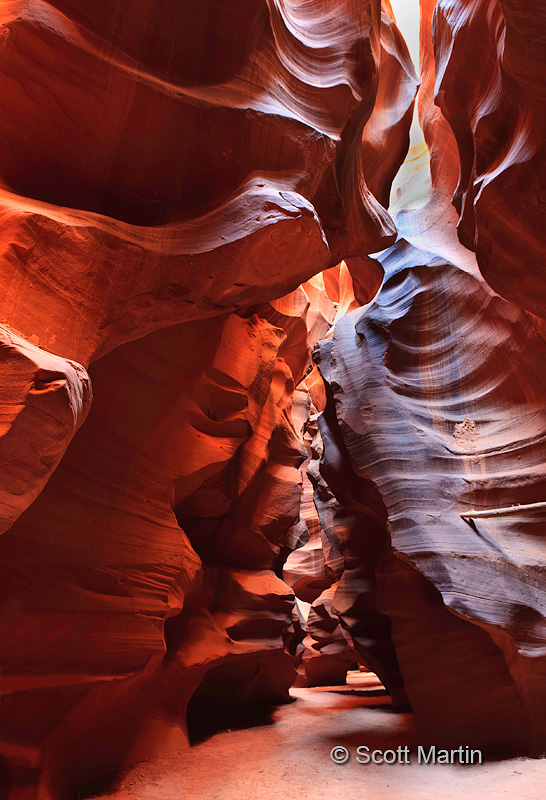
The stick on the right of the image below would have been deposited when the last storm waters moved through the canyon.
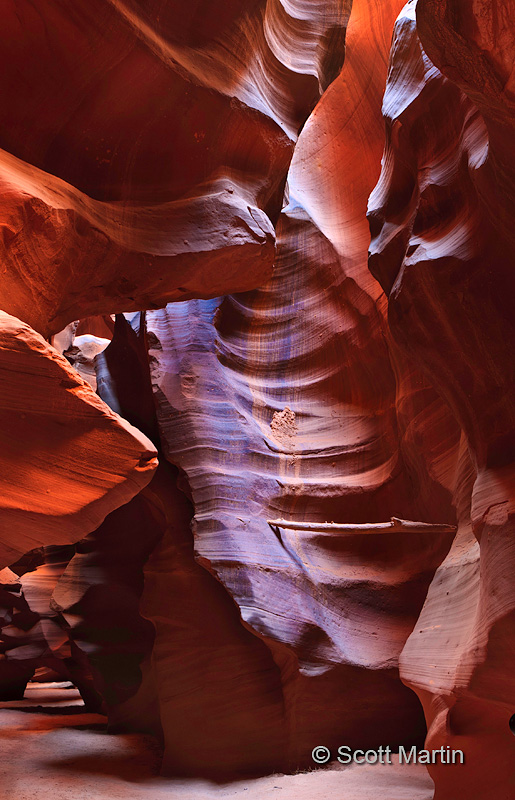
.
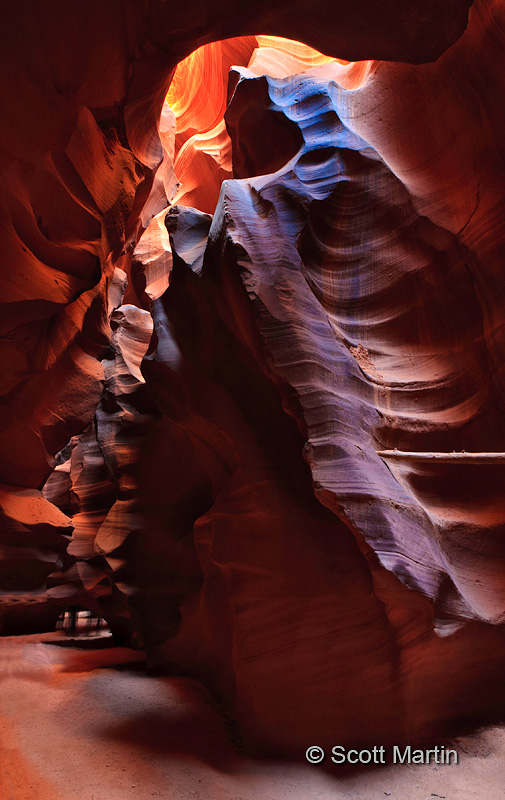
.
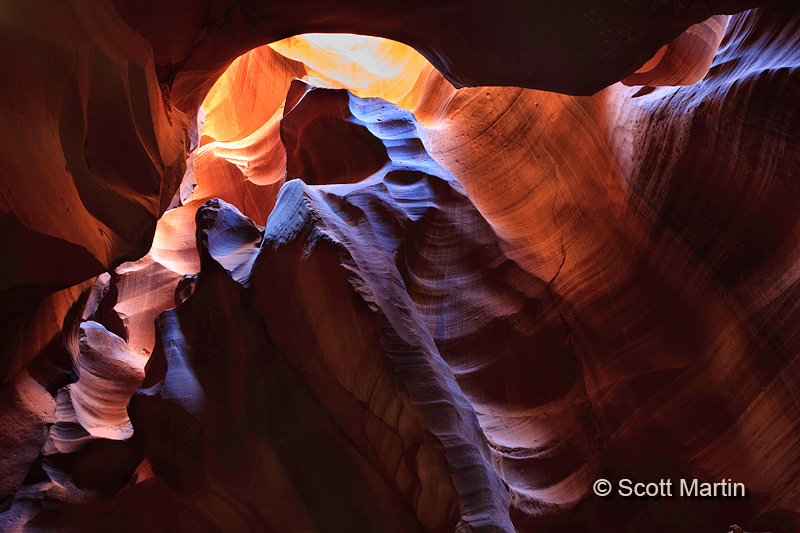
.
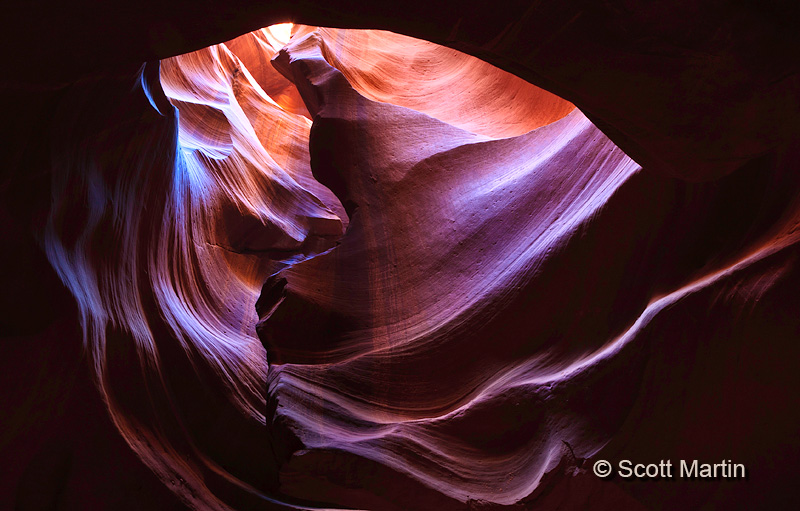
.
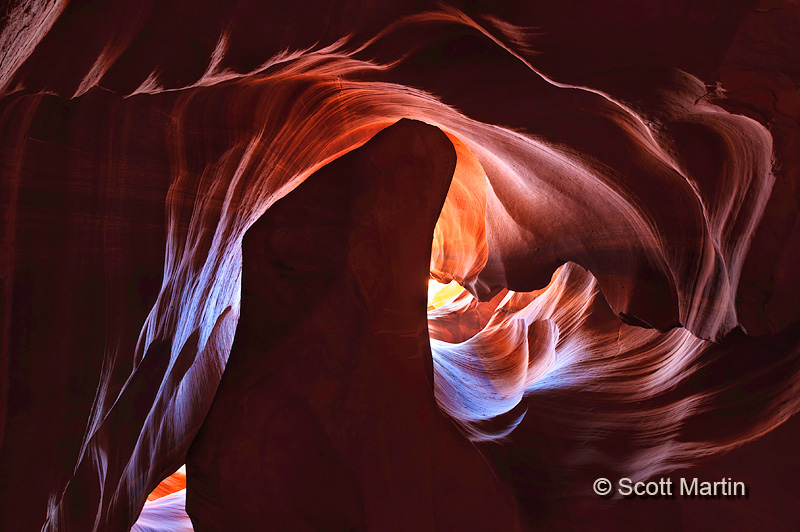
This next image is of the Antelope Canyon waterfall which is created by throwing a huge handful of sand on the rock wall and taking advantage of the long time exposure to create the waterfall effect.

The next few images are my attempt to be creative, which is always a challenge. The following two images are the same except for the exposure time is much less in the first therefore bringing out the deep blues and violets in the rocks.
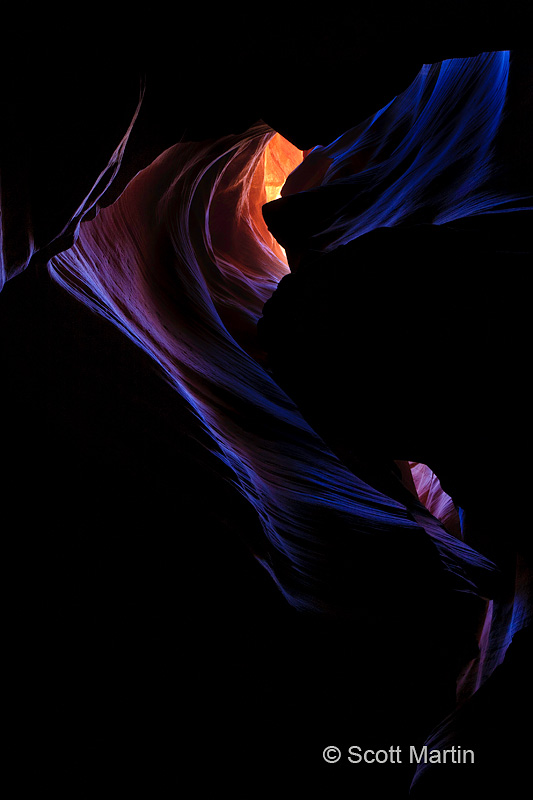
.
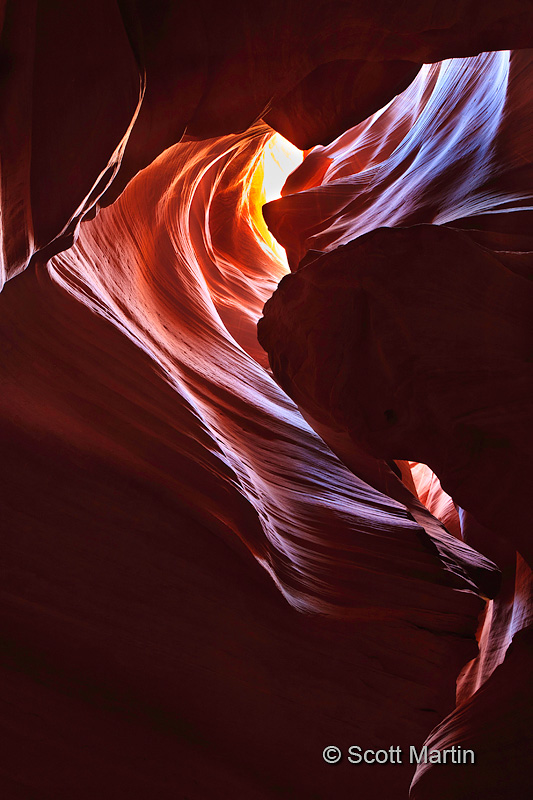
.
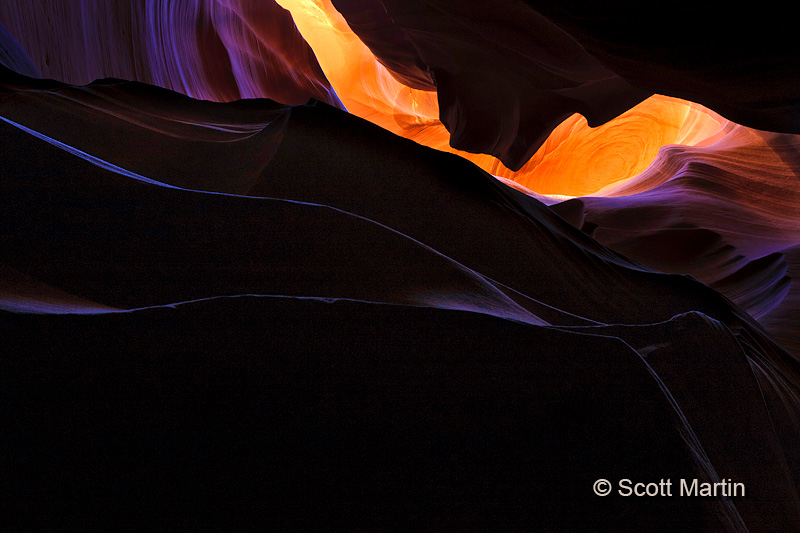
This last shot is the far end of the slot canyon. It took almost two hours to work our way from one end to the other and about ten minutes to rush back through the slot and back to the truck.
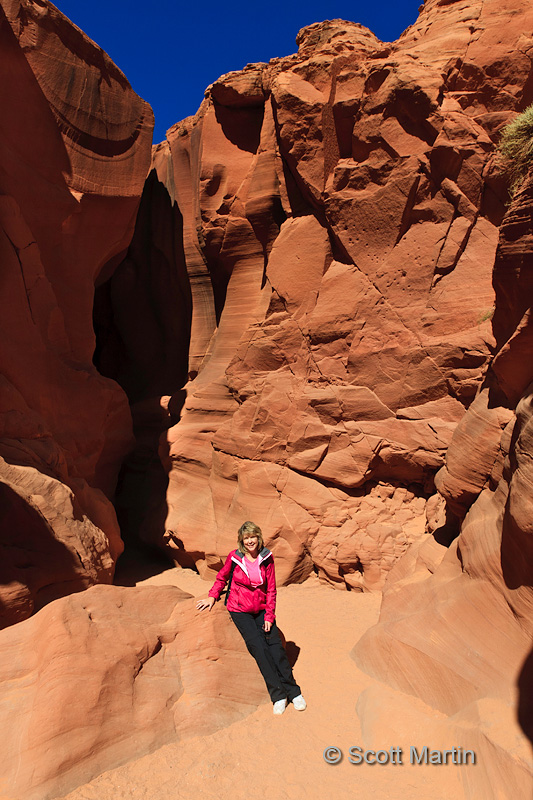
These images and a few more can be seen in the Antelope Canyon Gallery
After leaving the Antelope Canyon we travelled about ten miles to the famous Horseshoe Bend in the Colorado River which will be the focus of an upcoming blog entry.
Visiting the Antelope Slot Canyons was a fantastic experience and I would highly recommend that the next time you are in the vicinity of the Grand Canyon you make it a point to visit Page. Page Arizona is in the north central part of the state and is about a four drive from either Phoenix or Las Vegas.
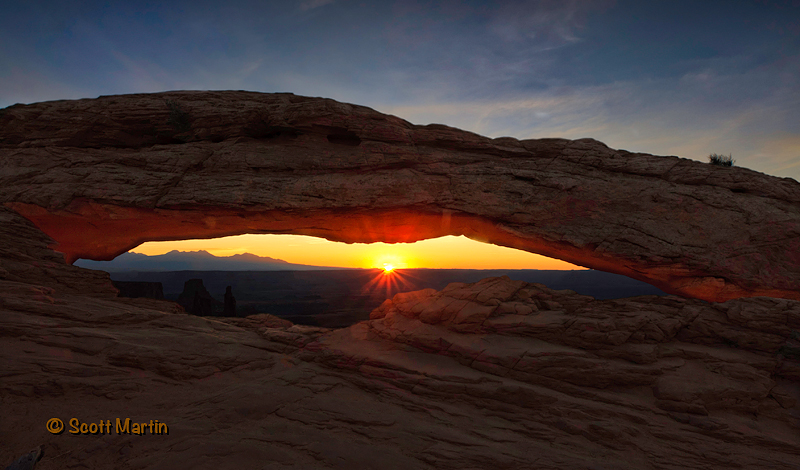
by Scott Martin Photography | Dec 25, 2011 | Blog, General, Landscapes, Naturescapes
It’s a pleasure for Deb & I to wish everyone a very Merry Christmas and Happy New Year for 2012. It is such a busy part of the year that time allowed for photography is at a minimum and keeping up to date with posting images and writing blog entries is almost impossible.
The single image in this post is of the famous Mesa Arch which is located in the ‘Islands of the Sky’ region within the vast Canyonlands National Park in Utah, USA. It is a ‘bucket list’ location for landscape photographers looking for that perfect sunrise shot and the effort required to be there was absolutely worth it. This shot was taken on a Saturday morning in October and we left our hotel room in Moab Utah at 4:30 a.m. and thirty-eight degrees for the almost hour-long drive into Canyonlands, where we parked at the trail-head in the dark and set out on the three-quarters of a mile hike under the moonlight to arrive at the arch in time to set up our gear and await the spectacular sunrise.
I will explain more about the experience and show many more images of the arch in upcoming posts, along with many other photographs from our recent trip through the American mid-west.
This image today is a Christmas one for a couple of reasons, the first is the sun breaking through the night sky reminds me of what it must have been like for the shepherds and wise men following the star that led them to Jesus over two thousand years ago. A celebration we continue to enjoy today, remembering an event that changed the world like none other ever has or ever will. Jesus is the only reason for the season. The second thing is the sunrise reminds us that a new day is upon us and at this time of year we take pause to think about the New Year that awaits us.
So once again, Merry Christmas and a blessed New Year to you and yours.

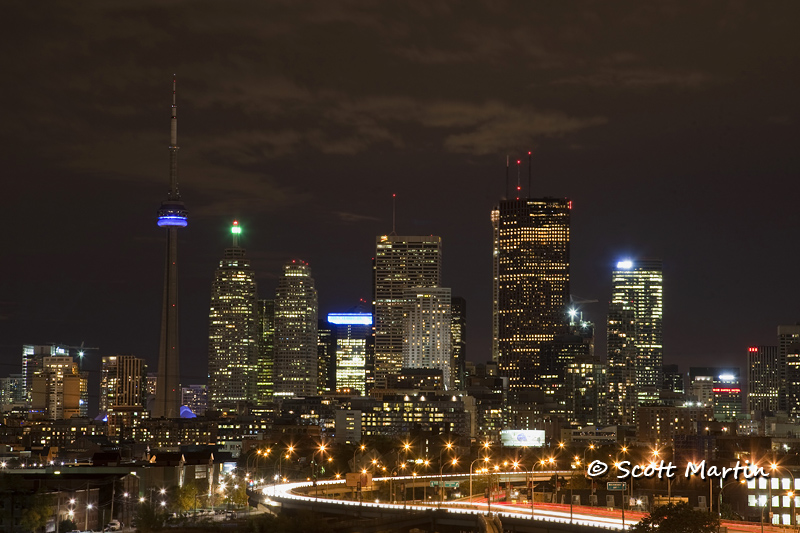
by Scott Martin Photography | Dec 5, 2010 | Blog, Cityscapes, Landscapes
October 2, 2010 marked the date for the fifth Nuit Blanche dusk to dawn contemporary art event. The event is held on the weekend before the Canadian Thanksgiving Weekend and has been growing each year since its inception in 2006 with more than a million people this year enjoying the exhibitions setup in various zones throughout the Toronto Downtown core. Most of the exhibitions involve light and the downtown buildings are often lit differently for Nuit Blanche, including the CN Tower. The concept of Nuit Blanche did not originate in Toronto, with the first organized events beginning in 1997. Controversy exists as to who started the very first Nuit Blanche – Paris, St. Petersburg or Berlin.
This year we spent the evening of Nuit Blanche at a good friend’s 50th birthday party, held at their downtown condominium which provided a beautiful view of the Toronto night-time skyline. Although cold, a roof-top terrace provided the perfect place to set up the tripod and shoot the Toronto nightscape from the East looking along Eastern Avenue.

When shooting night scenes you really should shoot while there is still blue in the sky. This allows the edges of the buildings to be easily differentiated. When the sky becomes black the edges of the building fade into the back ground and the visual impact of the image is lost. Although these images were take long after dark, they do work well as there is enough stray light from the city centre that the building edges are illuminated.
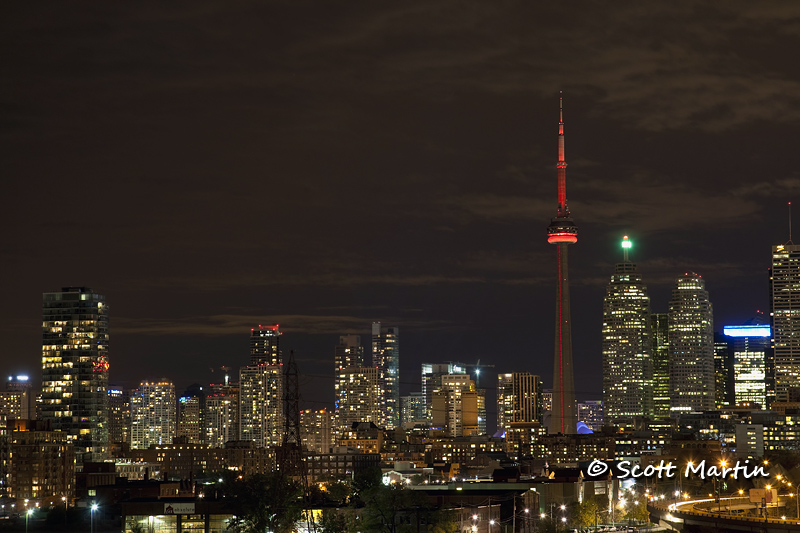
Thanks to Nuit Blanche the CN Tower is red!
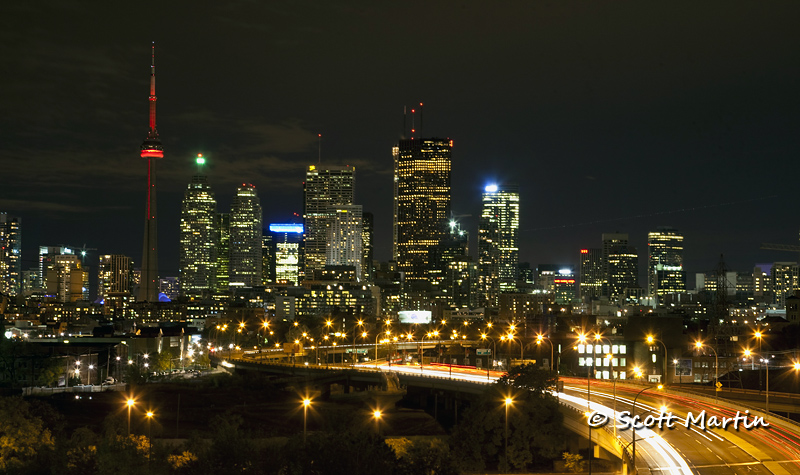
The star burst effect around the street lights is created by using a small aperture and as the aperture diameter increases the starburst effect is lost. You can also create the same effect with a star-cross filter, however that is more expensive and less fun than learning how to use aperture to control the star burst effect. The small apertures causes the exposure time required to increase significantly, however that is why you always have a tripod available.
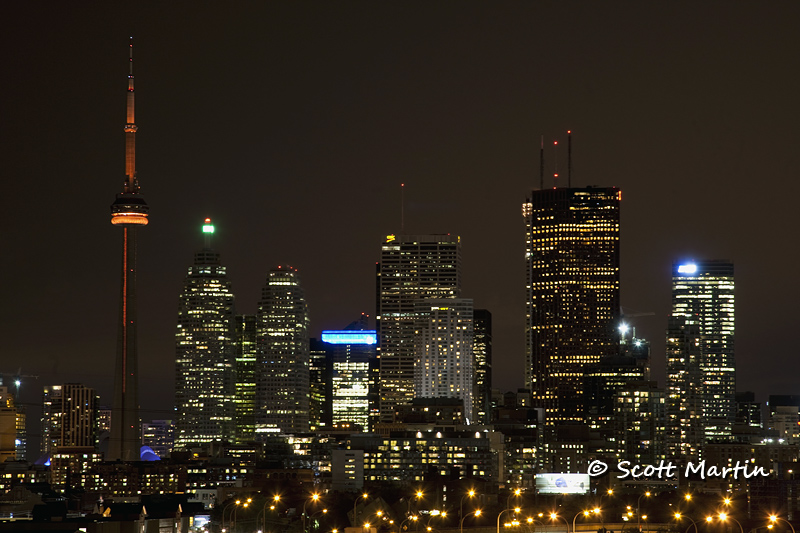
You can see other Cityscapes in the Cityscapes Gallery. There are some night shots of the Washington Capitol Building which will illustrate the value of shooting night scenes while there is still some blue in the sky.





















































Follow Scott Martin Photography